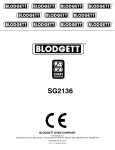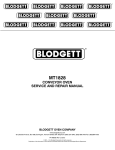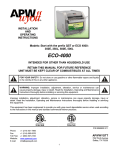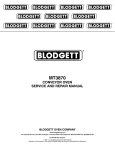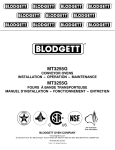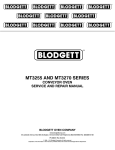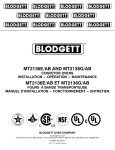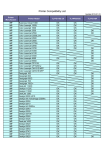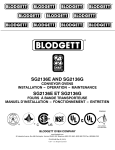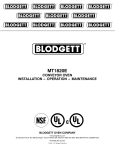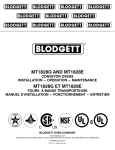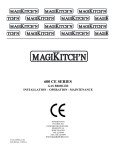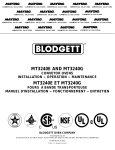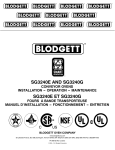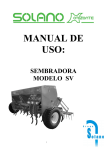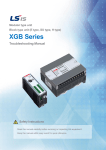Download Blodgett MT1828 Series Owner`s manual
Transcript
BLODGETT CONVEYOR STARTUP AND CALIBRATION GUIDE BLODGETT OVEN COMPANY www.blodgettcorp.com 50 Lakeside Avenue, Box 586, Burlington, Vermont 05402 USA Telephone (800) 331-5842, (802) 860-3700 Fax: (802)864-0183 PN M9437 Rev E (6/01) E 2000 --- G.S. Blodgett Corporation Table of Contents Introduction Pre-Startup Requirements . . . . . . . . . . . . . . . . . . . . . . . . . . . . . . . . . . . . . . . . . 2 Manual Control Startup Control Identification . . . . . . . . . . . . . . . . . . . . . . . . . . . . . . . . . . . . . . . . . . . . . . Gas Pressure Adjustments . . . . . . . . . . . . . . . . . . . . . . . . . . . . . . . . . . . . . . . . Temperature Control Configuration . . . . . . . . . . . . . . . . . . . . . . . . . . . . . . . . . Temperature Calibration . . . . . . . . . . . . . . . . . . . . . . . . . . . . . . . . . . . . . . . . . . . Motor Control Board Adjustment . . . . . . . . . . . . . . . . . . . . . . . . . . . . . . . . . . . Belt Speed Calibration . . . . . . . . . . . . . . . . . . . . . . . . . . . . . . . . . . . . . . . . . . . . Closed Loop --- Dart Microdrive MDP . . . . . . . . . . . . . . . . . . . . . . . . . . . . Open Loop . . . . . . . . . . . . . . . . . . . . . . . . . . . . . . . . . . . . . . . . . . . . . . . . . . . Convection Blowers and Ventilation . . . . . . . . . . . . . . . . . . . . . . . . . . . . . . . . . 3 4 5 6 7 8 8 9 10 Computer Control Startup Control Identification . . . . . . . . . . . . . . . . . . . . . . . . . . . . . . . . . . . . . . . . . . . . . . Gas Pressure Adjustments . . . . . . . . . . . . . . . . . . . . . . . . . . . . . . . . . . . . . . . . Convection Blowers . . . . . . . . . . . . . . . . . . . . . . . . . . . . . . . . . . . . . . . . . . . . . . Computer Configuration . . . . . . . . . . . . . . . . . . . . . . . . . . . . . . . . . . . . . . . . . . Temperature Calibration . . . . . . . . . . . . . . . . . . . . . . . . . . . . . . . . . . . . . . . . . . . Belt Speed Calibration . . . . . . . . . . . . . . . . . . . . . . . . . . . . . . . . . . . . . . . . . . . . Closed Loop Single Belt . . . . . . . . . . . . . . . . . . . . . . . . . . . . . . . . . . . . . . . Open Loop Twin Belt . . . . . . . . . . . . . . . . . . . . . . . . . . . . . . . . . . . . . . . . . . Ventilation . . . . . . . . . . . . . . . . . . . . . . . . . . . . . . . . . . . . . . . . . . . . . . . . . . . . . . . Motor Control Board Adjustment . . . . . . . . . . . . . . . . . . . . . . . . . . . . . . . . . . . 11 12 13 14 15 16 16 17 17 18 PLC Control Startup Control Identification and Registration . . . . . . . . . . . . . . . . . . . . . . . . . . . . . . Gas Pressure Adjustments . . . . . . . . . . . . . . . . . . . . . . . . . . . . . . . . . . . . . . . . Convection Blowers . . . . . . . . . . . . . . . . . . . . . . . . . . . . . . . . . . . . . . . . . . . . . . Temperature Calibration . . . . . . . . . . . . . . . . . . . . . . . . . . . . . . . . . . . . . . . . . . . Belt Speed Calibration . . . . . . . . . . . . . . . . . . . . . . . . . . . . . . . . . . . . . . . . . . . . 19 20 23 24 26 Introduction Pre-Startup Requirements U.S. installations a.) Add the total BTU’s/hr of all the gas appliances on the line. b.) Convert BTU’s to cubic ft/hr using the formula Cu Ft/Hr = 1000 BTU/Hr. c.) Size the meter accordingly. OWNER’S RESPONSIBILITIES A minimum of 5 to 7 working days are needed to schedule a start-up procedure. Before a factory representative, or a factory trained representative, arrives to perform a startup procedure, the owner MUST ALREADY have satisfied the following requirements: General export and Canadian installations a.) Add the total M3/min of all the appliances on the line. b.) Size the meter accordingly. 1. Gas Models: Installation of an adequate mechanically driven ventilation system for the unit. The ventilation system should replace 80% of the exhaust volume with fresh make up air. The table below can be used as a guideline. 2. Electric supplies installed by a certified professional. NOTE: Refer to the Owner’s manual provided with the oven for electrical specifications. 3. Gas Models: Gas supplies installed by a certified professional. NOTE: Refer to the Owner’s manual provided with the oven for gas specifications. Be sure to size the meter for all gas models as follows: Oven Model M d l NOTE: Refer to the Owner’s manual provided with the oven for additional information on utility installation requirements. SERVICE AGENCY’S RESPONSIBILITIES Before performing a start-up procedure, the service agency MUST ALREADY have satisfied the following requirements: 1. Assembly of the oven(s). NOTE: Refer to the Owner’s manual provided with the oven for assembly. 2. Conversion of ovens to other types of gas when required. Exhaust Volume -- CFM (M3/min) Single Double Triple Supply Requirements -- CFM (M3/min) Single Double Triple MT1828G 400-500 (14-17) 800-1000 (23-28) 1200-1500 (34-43) 320-400 (12-14) 640-800 (18-23) 960-1200 (27-34) SG2136G or MT2136G 400-500 (14-17) 800-1000 (23-28) 1200-1500 (34-43) 320-400 (12-14) 640-800 (18-23) 960-1200 (27-34) SG3240G or MT3240G 800-1000 (23-28) 1200-1600 (34-46) 2000-2400 (57-68) 640-800 (18-23) 960-1280 (27-36) 1600-1920 (46-54) MT3255G 1000-1400 (28-40) 2000-2800 (57-79) 3000-4100 (85-116) 800-1120 (23-32) 1600-2240 (46-64) 2400-3300 (68-93) MT3270 1200-1650 (34-47) 2400-3300 (68-93) 3600-5000 (102-142) 960-1320 (27-37) 1920-2640 (54-75) 2880-4000 (82-113) MG3270 1200-1650 (34-47) 2400-3300 (68-93) 3600-5000 (102-142) 960-1320 (27-37) 1920-2640 (54-75) 2880-4000 (82-113) MT3855 1000-1400 (28-40) 2400-3300 (68-93) 3600-5000 (102-142) 800-1120 (23-32) 1920-2640 (54-75) 2880-4000 (82-113) MT3870 1200-1650 (34-47) 2400-3300 (68-93) 3600-5000 (102-142) 960-1320 (27-37) 1920-2640 (54-75) 2880-4000 (82-113) 2 Manual Control Startup Control Identification The following instructions are for the standard manual control. See Figure 1 for control identification. ON OFF HEAT COOK TIME ON ACTUAL SETPOINT HEAT OFF TEMPERATURE CONVEYOR Figure 1 3 ON OFF BLOWER Manual Control Startup Gas Pressure Adjustments THE FOLLOWING STARTUP PROCEDURES MUST BE PERFORMED BY A QUALIFIED TECHNICIAN ONLY. Turn the adjusting screw on the left front side of the dual regulated valve to adjust the gas pressure. Turn the screw clockwise to raise the gas pressure and counter-clockwise to lower it. REGULATED GAS PRESSURE PRIMARY AIR ADJUSTMENT NOTE: Gas models only. NOTE: Gas models only. Incoming static gas pressure to the unit, with all the gas appliances drawing from the supply, should be a minimum of 5.5” W.C. (13.7 mbar) for natural gas and 11” W.C. (28 mbar) for propane gas. The air shutter disc on the burner blower motor, located inside the control box at the top of the assembly, is factory adjusted to provide the most efficient blue flame possible at sea level. The manifold pressure, if measured after the regulator located inside the control box, must be 3.5” W.C. (9 mbar) for natural gas and 10” W.C. (25 mbar) for propane gas. 1. Visually examine the quality of the flame. 2. If it needs adjusting, increase or decrease the air mixture to attain the best flame quality. The pressure can be checked at the tap on either the dual regulated gas valve or the solenoid valve. Regulator Cap Pressure Tap Regulator Adjustment Figure 2 4 Manual Control Startup Temperature Control Configuration CONFIGURATION PROCEDURES Setting the Deviation Band Alarm NOTE: Follow these configuration procedures to change the factory settings. The deviation band alarm causes the display to flash when the actual temperature varies (in either direction) from the setpoint. The deviation band alarm is adjustable to off or values from 1_F to 252_F (0.5_C to 122_C). To enter the Configuration Menus 1. Press and hold the actual temperature key for approximately 10 seconds. When the menu system has been accessed, the display toggles between dEF and either SP or Act. 1. Use the arrow keys to select the desired deviation band alarm. NOTE: We recommend 20_F (11_C). 2. Press the actual temperature key to enter the selected alarm value. Setting the Default Display The default display determines whether the controller displays the actual or setpoint temperature. To exit the Configuration Menus 1. Use the arrow keys to select the desired display default. NOTE: We recommend using the setpoint display default. 2. Press the actual temperature key to enter the selected display default. The display toggles between HYS and a numerical value. 1. Push and hold the actual temperature key for approximately 3 seconds. NOTE: The unit exits the configuration menus if the controller is not touched for 1 minute at any time during programming. SETTING THE DISPLAY UNITS Setting the Control Hysteresis 1. Press and hold the actual temperature key for approximately 10 seconds until the display reads unt and flashes F or c. Press the up or down arrow key to toggle between _F and _C. 2. Press and hold the actual temperature key until the control exits the programming mode. The control hysteresis, or burner cycle is used to prevent rapid cycling around the setpoint. The hysteresis is adjustable from 2_F to 252_F (1_C to 122_C). 1. Use the arrow keys to select the desired control hysteresis. NOTE: We recommend 5_F (3_C) initially. 2. Press the actual temperature key to enter the selected hysteresis value. The display toggles between OFF and a numerical value. Setting the Display Offset The display offset adjusts the displayed temperature if the actual temperature differs from the temperature seen by the thermocouple. If the actual temperature is lower a positive offset is needed. If the actual temperature is higher a negative offset is needed. The display offset is adjustable from -126_F to +126_F (-87_C to +52_C). ACTUAL 1. Use the arrow keys to select the desired display offset. 2. Press the actual temperature key to enter the selected offset value. The display toggles between ALr and a numerical value. SETPOINT Figure 3 5 HEAT Manual Control Startup Temperature Calibration Low Limit Adjustment High Limit Adjustment 1. Bring the oven to 200_F (93_C). 2. Turn the blower and heat switches to OFF. The blower should continue to run. 3. Monitor the digital temperature control display. The blower motors should shut off within the range of 170-135_F(77-57_C). 4. To adjust the temperature, turn the low-limit potentiometer. A clockwise rotation increases the setting, counter-clockwise decreases it. See Figure 4. NOTE: Refer to the wiring diagram shipped with the oven for terminal locations. P2 INCREASE P1 INCREASE 1. Remove the wires from the common and N.O. terminals. Touch the wires together to energize the heat circuit. This enables the oven to heat above the highest temperature allowed by the controller. 2. When the display reads 600_F (316_C), the burner blower motor should shut off. If the temperature rises above 600_F (316_C), adjust the hi-limit pot (Figure 4) so the burner shuts off at 600_F (316_C). A clockwise rotation of the high-limit pot increases the temperature, counter-clockwise decreases it. P3 9 T/C 10 RED + DECREASE DECREASE DECREASE LOW LIMIT HI LIMIT INCREASE ACTUAL T1 INCREASE HI LIMIT SETPOINT HEAT DECREASE LOW LIMIT ZYTRON SERIES 300 Athena Temperature Controller 1 1 2 3 230 115 4 NC 5 6 C NO 7 8 NO C United Electric Board 3 2 115 230 4 7 8 6 5 NO C NC NO C OUTPUT 1 OUTPUT 2 Zytron Board Figure 4 6 Manual Control Startup Motor Control Board Adjustment Low Speed Motor Adjustment: High/low speed motor control board adjustment for 180 and 130 VDC motors 1. Turn the cook time control knob on the front panel fully counter-clockwise to increase the cook time. 2. With the motor connected (make no open circuit voltage readings) measure the voltage at the motor leads on the DC control board (A1 & A2 in Figure 5). If the voltage is not within 1 VDC of the specified voltage, continue with step 3. 3. Turn the MIN SPEED pot clockwise to lower the voltage and counter-clockwise to raise the voltage. NOTE: This procedure does not apply to Dart Microdrive systems or cooking computers. NOTE: The motor control board is located on the slide out control panel. High Speed Motor Adjustment: 1. Turn the cook time control knob on the front panel fully clockwise to decrease the cook time and turn the conveyor belt on. 2. With the motor connected (make no open circuit voltage readings) measure the voltage at the motor leads (A1 & A2 in Figure 5) on the DC control board. If the voltage is not within 3 VDC of the specified voltage continue with step 3. 3. Turn the MAX trim pot counter-clockwise to lower and clockwise to raise the voltage until it is within 3 VDC of the specified voltage. Model 130 Volt System 180 Volt System Low High Low High MT2136 20 130 26 180 MT3255 26 130 26 180 MT3270 26 130 26 180 MG3270 26 130 N/A N/A Minimum Speed Pot Maximum Speed Pot ACC Yellow or Violet (pin 12) MAX Orange or Gray (pin 10) TORQ ON TP2 REG J1 Blue Gray MIN TP1 Blue (pin 8) Violet Torque (current) limiting adjustment (DO NOT ADJUST) FL TB1 Speed Pot L N A1 A2 + Line Hot (VAC) Line Neutral (VAC) - FA Barrier Terminal Block TB1 Power Line and Motor Ground PM Motor Armature REMOVE RED PLUG FROM TOP OF DC MOTOR PRIOR TO OPERATING! Warning: Circuit components are not at ground potential! Use only a non-metallic or insulated adjustment tool. Shock hazards may occur with conducting tools! Figure 5 7 Manual Control Startup Belt Speed Calibration NOTE: For ovens with a 70” (178 cm) tunnel the preset constant is 5:20. For ovens with a 55” (140 cm) tunnel the preset constant is 4:08. 3. When finished, set DIP switch 1 to OFF. 4. The display reads PROG. CLOSED LOOP -- DART MICRODRIVE MDP 1. Remove the top cover. The internal dip switch is located next to the transformer. NOTE: If you change the constant, the display setting will be set to the slowest speed when you exit the programming mode. Minimum Setting Dip Switch Detail O 1 2 3 4 5 6 7 8 N 1. Flip DIP switch 2 to ON. 2. The display gives the current value for the lower limit. To change press the up or down arrow keys. 3. When finished flip DIP switch 2 to OFF. 4. The display reads PROG. Figure 6 PROGRAMMING THE MDP CONTROL Maximum Setting NOTE: Any variable can be changed WITHOUT resetting the others. 1. Flip DIP switch 3 to ON. 2. The display gives the current value for the upper limit. To change press the up or down arrow keys. 3. When finished flip DIP switch 3 to OFF. 4. The display reads PROG. To Exit the Program Mode To Enter the Program Mode 1. Set DIP switches 1, 2, 3, 4, 5, 6 and 8 to OFF. Set DIP switch 7 to ON. The motor stops. 2. The display reads PROG. NOTE: In rate mode the current decimal point is also displayed. Time or Rate Mode (Displayed Decimal Place) 1. Make sure DIP switch 5 (Master/Follower Mode select) is in the desired position (ON = Follower; OFF= Master). NOTE: In most cases DIP switch 5 should be set to the master position (OFF). 2. Set DIP switches 1, 2, 3, 4, 6 and 8 to OFF. 3. If satisfied with programming values, set DIP switch 7 to OFF. The control operates using the new programmed variables. This allows settings to be made in the proper units. 1. Set DIP switch 4 to ON. 2. The current decimal point (if any) will be lit. The display gives the current value of the decimal place variable. To change press the up or down arrow keys. Use 0-4 for the rate mode. Use 5 for the time mode. NOTE: The decimal point will not be lit if the unit is currently in the time mode. 3. When finished, flip DIP switch 4 to OFF. 4. The display reads PROG. K Constant CHECKING THE BELT SPEED CALIBRATION Place a pan on the belt and start the conveyor. 1. Begin timing the belt’s speed when the trailing edge of the pan enters the oven. 2. End the timing cycle when the trailing edge of the pan exits the oven. 3. If the displayed time differs from the actual more than 5 seconds, reprogram the K constant. 1. Flip DIP switch 1 to ON. 2. The display gives the current value for the constant. To change press the up or down arrow keys. 8 Manual Control Startup Belt Speed Calibration OPEN LOOP Set The Belt Speed DIP Switches. The following procedure must be performed after dc voltage levels have been set and are known to be accurate. Set the DIP switches using the data from the table below. Model Hall Effect pickup identification Pickup DIP Switch Setting 60 Hz Motors NOTE: The cook time digital display should be adjusted when changing any of the system components. MT2136 Single 7, 5, 2, 1 --- set to OFF 5 Pulse 6, 4, 2 --- set to OFF Prior to adjusting the display, determine the number of pulses per spindle revolution generated by the Hall effect pickup. MT3255 Single 8, 1 --- set to OFF 5 Pulse 7 --- set to OFF 1. Move the plastic end-caps on the pickup located on the DC motor. 2. If the pickup is marked with the number 2, it is a single pulse per revolution pickup. If the pickup is marked with the number 10 (Standard After 6-1-91) it is a five pulse per revolution pickup. 3. Replace the end-caps. 4. Verify the potentiometer setting. a.) Remove the screws securing the cook time display lens cover. Remove the lens cover. b.) If a 5 pulse pickup is used, verify that the multiplier potentiometer is set to the x10 position. Refer to Figure 7. MT3270 Single 8, 6, 2 --- set to OFF 5 Pulse 7, 5, 1 --- set to OFF 50 Hz Motors MT2136 Single 7, 6, 2 --- set to OFF 5 Pulse 5, 4, 1 --- set to OFF MT3255 Single 8, 5, 3, 2 --- set to OFF 5 Pulse 7, 4, 2, 1 --- set to OFF MT3270 Single 8, 6, 5, 4, 3, 2, 1 --- set to OFF 5 Pulse 7, 5, 4, 3, 2, 1 --- set to OFF Belt speed DIP switches located behind cook time digital display Rear Of Control Cooking Time Switch Number 8 7 6 5 4 3 2 1 8 4 2 1 OFF 128 64 INCREASE X10 X1 32 16 Switch Value DECREASE Multiplier potentiometer located behind cooking time digital display Figure 8 For 5 pulse pickups set to x10 Figure 7 9 Manual Control Startup Convection Blowers and Ventilation The correct motor rotation amperage draw for most Blodgett Conveyor ovens is 1 amp. If the amperage draw is less than .5 amp, check for proper motor rotation direction. 1. Remove the back of the oven body to check motor rotation direction. See Figure 9. Due to the vertical positioning of the motors in Blodgett Conveyor ovens, the motor direction is Blower Motor (Side view) VENTILATION Ignite a smoke bomb inside the oven cavity. Note the amount of smoke removed by the ventilation system. The minimum recommended amount of exhaust volume to be removed is 80%. MT2136 BLOWER WHEEL ROTATION Motor #1 Control Box Slinger Cooling Blade reference from the end of the motor (EOM) as viewed from the rear of the oven. In the following figure all directions are taken from EOM. Motor #2 MT3255 BLOWER WHEEL ROTATION Motor #1 Motor #2 Motor #3 Control Box MOTOR ROTATION OF CONVECTION BLOWERS (Top view) Motor #2 Motor #3 Control Box Motor #1 Motor #1 Figure 9 10 Motor #2 Motor #3 Motor #4 Control Box MT3270 BLOWER WHEEL ROTATION MG3270 BLOWER WHEEL ROTATION (motor outside oven) Computer Control Startup Control Identification The following instructions are for computer controlled oven. See Figure 10 for control identification. Figure 10 11 Computer Control Startup Gas Pressure Adjustments THE FOLLOWING STARTUP PROCEDURES MUST BE PERFORMED BY A QUALIFIED TECHNICIAN ONLY. REGULATED GAS PRESSURE NOTE: Gas models only. 1. Let the oven heat to 510_F (266_C). Program the belt speed for 7 minutes. 2. Check the pressure at the tap on the dual regulated gas valve or at the tap on the tee valve. Incoming static gas pressure to the unit, with all the gas appliances drawing from the supply, should be a minimum of 5.5” W.C. (14 mbar) for natural gas and 11” W.C. (28 mbar) for propane gas. The manifold pressure must be 3.5” W.C. (9 mbar) for natural gas and 10” W.C. (25 mbar) for propane gas. This measurement should be taken after the regulator located inside the control box. The pressure can be checked at the tap on either the dual regulated gas valve or the solenoid valve. Turn the adjusting screw on the left front side of the dual regulated valve to adjust the gas pressure. Turn the screw clockwise to raise the gas pressure and counter-clockwise to lower it. NOTE: Be sure to reinstall the screw cap; if the diaphragm ruptures the cap acts as a flow limiter. PRIMARY AIR ADJUSTMENT NOTE: Gas models only. The air shutter disc on the burner blower motor, located inside the control box at the top of the assembly, is factory adjusted to provide the most efficient blue flame possible at sea level. 1. Visually examine the quality of the flame. 2. If it needs adjusting, increase or decrease the air mixture to attain the best flame quality. NOTE: For MT1828G, manifold pressure must be 3.5” W.C. for both Natural gas and Propane. Regulator Cap Regulator Adjustment Pressure Tap Figure 11 12 Computer Control Startup Convection Blowers Motor Rotation of Convection Blowers Checking the Low Limit of the Blowers: The correct amp draw for most conveyor ovens is 1 amp. For MT1828 the correct amp draw is .6 (cold) and .3 (hot). 1. Turn the oven on. Let it heat to approximately 200_F (93_C). Shut the oven off. The blowers should come back on in several seconds. 2. When the blowers shut off, turn the oven on. Press the ACT TEMP key to verify that the blowers shut off from 135-170_F (57-77_C). If the amp draw is less than .5 (for MT1828 use .3 cold and .1 hot), remove the back of the oven and check for proper motor rotation direction. See Figure 12. Due to its vertical positioning the motor direction is reference from the end of the motor (EOM) as viewed from the rear of the oven. MT1828 BLOWER WHEEL ROTATION Slinger Cooling Blade Motor #1 (Side view) (Top view) Motor #1 Motor #2 Motor #2 Motor #3 Motor 2 Motor #3 Motor #1 Figure 12 13 Motor #2 Motor #3 Motor #4 Control Box Motor #1 Motor #1 MT3270 and MT3870 BLOWER WHEEL ROTATION Control Box MT3855 BLOWER WHEEL ROTATION MT3240 (3 blower) BLOWER WHEEL ROTATION Control Box MT3240 (2 blower) BLOWER WHEEL ROTATION Control Box Motor #2 Control Box MT2136 BLOWER WHEEL ROTATION Motor #1 Motor #2 Control Box Blower Motor Computer Control Startup Computer Configuration The cooking computer access mode displays certain computer special functions. Entering the Access Mode: 1. With the oven plugged in the display reads OFF. Press the following sequence of keys CLEAR 1 2 3 4 5 6 ENTER. 2. The display reads ACCESS. Checking the Firmware Model: 1. From the access mode press CLEAR 1 2 3 ENTER. The display scrolls through the following data then returns to the access mode. MODEL computer model # (6028) SW-VER Firmware version number V-xxyy xx = major version yy = minor version DATE-? Firmware release date CHKSUM ROM checksum stored in PROM xxxx --- value in display hexadecimal format. NOTE: This mode is for verification only. Do not try to input data in this mode. 2. Record the SW-VER (Software Version Number) on the start-up sheet. 3. The control automatically returns to the access mode. Computer Configuration: 1. From the access mode, press the following keys: CLEAR 1 1 1 ENTER. The display reads F/CMODE? (temperature scale) 2. Press the PROG/ENTER key to view the programmed temperature scale. If necessary, press any numeric key to toggle the display units. 3. Press the PROG/ENTER key to store the setting and advance the control to the next function. 4. Repeat steps 2---3 for all special functions. With the exception of the offsets, to be addressed later, all display data should match the table below. If necessary, use the numeric keys to change the data. NOTE: To return to a previous entry press the CLEAR key. 5. After the T-CTRL INTEG is entered the display reads EXIT then returns to the access mode. Special Function Recommended Settings F/CMODE? T ' F_(_C) POS OFFSET? 0_(0_) NEG OFFSET? 0_(0_) MAX-T ENTRY? 600_(315_) MAX-T LIMIT? 625_(330_) READY BAND? 10 MIN-HT ON? 60 DISPLAY INTEG? 30 T-CTRL INTEG? 10 5 (MT3870 only) Exiting the access mode: 1. Press and hold the ON/OFF key. The oven defaults to 0. NOTE: A new time and temperature must be entered before the oven will re-ignite. 14 Computer Control Startup Temperature Calibration After the oven has been cycling at the normal temperature for 30 minutes, place a temperature probe in the center of the oven to verify proper calibration. If the oven is not cycling to within ¦ 5_F (3_C) of the setpoint use the following calibration procedure. Entering the calibration mode: 1. Press the ON/OFF key until OFF is displayed. 2. Press CLEAR 1 2 3 4 5 6 ENTER to enter the access mode. The display reads ACCESS. 3. Press CLEAR, ACT TEMP, ACT TEMP, ACT TEMP, ENTER to access the temperature calibration mode. 4. Disconnect the white wire from the D.C. motor. Secure so the wire cannot ground against any part of the oven. This disables the conveyor. NOTE: Disregard the controller display. The only numbers of concern are the probe reading and the temperature set point. To view the current temperature setpoint: 1. Press the SET TEMP key. 1. Press PROG/ENTER followed by ACT-TEMP. The display flashes either POS * OFFSET or NEG * OFFSET. NOTE: The display reads POS * OFFSET if a value has been programmed in for a positive offset. The display reads NEG * OFFSET if a value has been programmed for a negative offset. Both are displayed if a value of 0 has been entered for each. 2. Enter a value for the desired offset. The display flashes DISPLAY * INTEG?. NOTE: The value must be added or subtracted from any existing offset. 3. Press the PROG/ENTER key. The default value of 30 is displayed. 4. Press the PROG/ENTER key. The display flashes T-CTRL * INTEG?. 5. Press the PROG/ENTER key. The default value of 10 is displayed (5 for MT3870). 6. Press the PROG/ENTER key. The control resumes using the new parameters. Exiting the calibration mode: To change the temperature setpoint: 1. Press PROG/ENTER, SET TEMP. 2. Enter the desired setpoint. 3. Press the PROG/ENTER key. To program a temperature offset: Temperature control is based on the measured temperature and the temperature offset programmed into the control. If the temperature measured in the center of the oven is below the oven setpoint a positive offset is needed. If the temperature measured in the center of the oven is above the oven setpoint a negative offset is needed. An offset, positive or negative, must be programmed to change the temperature calibration. 1. Press the CLEAR key twice. 2. The display flashes REBOOT then displays the set time and temperature. You must re-enter a temperature for the oven to start heating again. a.) Press PROG/ENTER, SET TEMP b.) Enter the desired temperature. c.) Press the PROG/ENTER key. The heat light turns on and the burner begins to cycle at set point. Verify the temperature calibration once the unit has cycled for 5 minutes with the new settings. Repeat calibration using a new offset value if necessary. 3. Turn oven off and reconnect the white wire to the D.C. motor. 15 Computer Control Startup Belt Speed Calibration CLOSED LOOP SINGLE BELT Place an object on the belt. Time its passage from entrance to exit. If the actual speed is not within ¦ 10 seconds of the setpoint calibrate as follows. NOTE: Measure the leading or the trailing edge in and out. Do not use the leading edge in and the trailing edge out. To enter the calibration mode: 1. Press the ON/OFF key until OFF is displayed. 2. Press CLEAR 1 2 3 4 5 6 ENTER. The display reads ACCESS. 3. Press CLEAR TIME TIME TIME ENTER. The display flashes INIT. 7. Belt speed calibration: NOTE: Use the data from the table below to program the following parameters. 1. 2. 3. 4. 5. OVEN LENGTH --- enter the conveyor length. MOTOR RATIO --- set the motor gear ratio. SHAFT TEETH --- set the shaft teeth number. MOTOR TEETH --- set the motor teeth number. BELT RADIUS --- set the belt radius. NOTE: Belt radius values given are estimates. If you re-enter the calibration mode after setting the belt speed, the belt radius may differ from the table. 6. The display gives a four digit value followed by the letter K. Press ENTER twice to verify the belt speed. Belt speed verification: 8. 9. 10. a.) ENTER TEST TIME --- Enter a test time. The default is 7 minutes. b.) WAIT --- 1 second delay. c.) ENTER ACTUAL TIME --- Place an object on the belt. Time its passage from entrance to exit. Enter the actual time. d.) ENTER TEST TIME --- If the actual time is not ¦ 5 seconds of the test time, repeat the belt verification test for better accuracy. If the actual measured time is acceptable, press the CLEAR key to continue with belt speed calibration. MAX/MIN CALC TIME --- The control determines the fastest and slowest programmable cook time. This requires a 1 minute delay. NOTE: If the control cannot read the shaft encoder the display reads ERROR then ABORT before exiting belt calibration. Verify the connection of the encoder Restart belt speed calibration. The display flashes MIN SET TIME? Press the PROG/ENTER key to display the calculated minimum set time. Press the PROG/ENTER key to accept this value. The display flashes MAX SET TIME? Press the PROG/ENTER key to display the calculated maximum set time. Press the PROG/ENTER key to accept this value. The display reads DONE. To save the new belt speed: 1. Press ENTER to save the belt speed calibration program in the control’s memory. Model Oven Length Motor Ratio Shaft Teeth Motor Teeth Belt Radius MT1828 28 600 24 24 7,209 MT2136 36 600 15 12 8,712 MT3240 40 600 15 12 8,893 MT3270 70 600 15 12 8,712 MT3855 55 600 15 12 8,712 MT3870 70 600 15 12 8,712 MT3870 Tandem 176 180 19 15 8,712 16 Computer Control Startup Belt Speed Calibration OPEN LOOP TWIN BELT Place an object on the belt. Time its passage from entrance to exit. If the actual speed is not within ¦ 10 seconds of the setpoint calibrate as follows. NOTE: Measure the leading or the trailing edge in and out. Do not use the leading edge in and the trailing edge out. Entering the Calibration Mode: 1. Press the ON/OFF key until OFF is displayed. 2. Press CLEAR, CLEAR, CLEAR, FRONT BELT, FRONT BELT, FRONT BELT, PROG/ENTER to enter the access mode. The display flashes ACCESS. 3. The display reads ACTIVE BELT ---?. Press FRONT BELT for front belt calibration. Press FRONT BELT again for rear belt calibration. 4. The display reads FRONT ---INIT ---F or REAR --INIT ---F. Belt Speed Calibration: 1. The display reads BELT SIZE ---?. Enter the length of the conveyor belt for your model from the table. Press the PROG/ENTER key. 2. The display reads STEP ---1. Step 1 calibrates the maximum belt speed. Place an object on the belt. Note the time from entrance to exit. a.) The display reads STEP ---1TIME ---?. Enter the time measured in STEP---1. Min: 0 Max: 59:59 (min:sec). Press the PROG/ ENTER key. b.) The display reads STEP ---1DIST ---?. Enter the belt length for your model from the table. Press the PROG/ENTER key. 3. The display reads STEP ---2. Step 2 calibrates the minimum belt speed. The belt travels slowly during this part of the calibration procedure. To minimize time spent on STEP---2, measure off 10” on the conveyor support. Place an object on the belt and note the travel time for the 10” measured distance. a.) The display reads STEP ---2 TIME ---?. Enter the measured travel time for STEP---2. Min: 0 Max: 59:59 (min:sec). Press the PROG/ENTER key. b.) The display reads STEP ---2 DIST ---?. Enter 10”. Press the PROG/ENTER key. 17 4. The display flashes MIN SET TIME? Press the PROG/ENTER key to display the calculated minimum set time. Press the PROG/ENTER key to accept this value. 5. The display flashes MAX SET TIME? Press the PROG/ENTER key to display the calculated maximum set time. Press the PROG/ENTER key to accept this value. 6. The display flashes DONE and SAVE. NOTE: DO NOT press the CLEAR key during belt speed calibration. The CLEAR key aborts all entries and the belt speed must be reprogrammed. After exiting belt speed calibration enter a cook time. Otherwise the time defaults to zero, the oven will not heat, and the belt will not move. Ventilation Ignite a smoke bomb inside the oven cavity. Note the amount of smoke removed by the ventilation system. The minimum recommended amount of exhaust volume to be removed is 80%. Computer Control Startup Motor Control Board Adjustment High/low speed motor control board adjustment for 180 and 130 VDC motors 2. With the motor connected (make no open circuit voltage readings) measure the voltage at the motor leads on the DC control board (A1 & A2 in Figure 13). If the voltage is not within 1 VDC of the specified voltage, continue with step 3. 3. Turn the MIN SPEED pot clockwise to lower the voltage and counter-clockwise to raise the voltage. NOTE: The motor control board is located on the slide out control panel. High Speed Motor Adjustment: 1. Turn the cook time control knob on the front panel fully clockwise to decrease the cook time and turn the conveyor belt on. 2. With the motor connected (make no open circuit voltage readings) measure the voltage at the motor leads (A1 & A2 in Figure 13) on the DC control board. If the voltage is not within 3 VDC of the specified voltage continue with step 3. 3. Turn the MAX trim pot counter-clockwise to lower and clockwise to raise the voltage until it is within 3 VDC of the specified voltage. Model Low Speed Motor Adjustment: 1. Turn the cook time control knob on the front panel fully counter-clockwise to increase the cook time. MT1828 20 130 26 180 MT2136 20 130 26 180 MT3240 26 130 26 180 MT3270 26 130 26 180 MT3855 26 130 26 180 MT3870 26 130 26 180 Maximum Speed Adjustment To Computer Minimum Speed Adjustment ACC MAX Green Wire 130 Volt System 180 Volt System Low High Low High TORQ MIN Blue Wire Red Wire Socket J1 Line Fuse 5 Amp Armature Fuse 200-250 ma FL TB1 L NOTE: Colors may vary between early ovens. N A1 + Line Hot (VAC) Line Neutral (VAC) A2 PM Motor Armature FA Barrier Terminal Block TB1 Power Line and Motor Ground REMOVE RED PLUG FROM TOP OF DC MOTOR PRIOR TO OPERATING! Warning: Circuit components are not at ground potential! Use only a non-metallic or insulated adjustment tool. Shock hazards may occur with conducting tools! Figure 13 18 PLC Control Startup Control Identification and Registration The following instructions are for both the standard manual and programmable menu PLC controls. See Figure 14 for control identification. THE FOLLOWING STARTUP PROCEDURES MUST BE PERFORMED BY A QUALIFIED TECHNICIAN ONLY. CONTROL REGISTRATION NOTE: The following control registration procedure applied to installations in North America only. The installer may be required to obtain a registration number from the Blodgett Oven Service Department before the unit can be operated. Use the following procedure for control registration: 1. Registration is required if after applying power to the oven for the first time the display reads: CALL SRVC FOR REG # 1-800-331-5842 2. Note the serial number of the oven and call Blodgett Oven Service at the number shown on the display to obtain your registration number. 3. Press the ENTER/RESET key. 4. The display reads: REG # XXX Standard Manual PLC Control Use the arrow keys to scroll to the registration number for your unit. Press the ENTER/RESET key to enter the registration number. 5. The display reads: OVEN OFF 6. The oven can now be turned on. Menu Programmable PLC Control VENTILATION Ignite a smoke candle inside the oven cavity. Note the amount of smoke removed by the ventilation system. The recommended amount of smoke to be removed is 90---100%. Figure 14 19 PLC Control Startup Gas Pressure Adjustments REGULATED GAS PRESSURE NOTE: Gas models only. 1. Let the oven heat to 510_F (266_C). 2. Check the pressure at the tap on the multi-function gas valve and at the tap on the tee fitting at the rear of the electrical box. See Figure 15. The manifold pressure must be 3.5” W.C. (8.7 mbar) for natural gas and 10” W.C. (25 mbar) for propane gas. This measurement should be taken at the Manifold and Pilot Pressure Tap. Incoming gas pressure to the unit, with all the gas appliances drawing from the supply, should be a minimum of 4.5” W.C. (11.2 mbar) for natural gas and 11” W.C. (27.4 mbar) for propane gas. The maximum gas pressure should not exceed 13” W.C. (32.3 mbar). This measurement should be taken at the Incoming Line Pressure Tap. 1. Unscrew the regulator adjustment cover cap. 2. Turn the adjusting screw inside the gas valve. NOTE: Turn the screw clockwise to raise the manifold pressure and counter-clockwise to lower it. 3. Reinstall the cover cap. Incoming Line Pressure Tap (Pipe plug used in US/CAN ovens) To adjust the manifold pressure Regulator Adjustment Cover Cap Regulator Adjustment Screw (inside) Manifold and Pilot Pressure Tap (Pipe plug used in US/CAN ovens) Figure 15 20 PLC Control Startup Gas Pressure Adjustments COMBUSTION BLOWER PRESSURE SWITCH ADJUSTMENT PRIMARY AIR ADJUSTMENT NOTE: Gas models only. The air shutter disc on the burner blower motor, located inside the control box on top of the burner, is factory adjusted to provide the most efficient blue flame possible at sea level. 1. Visually examine the quality of the flame. 2. If it needs adjusting, increase or decrease the air mixture to attain the best flame quality. Be sure to tighten the lock nut when finished. NOTE: If there is no sight glass in the end of the burner, open the front access door completely. Look beneath the nozzles to view the flame quality. 3. If the combustion blower alarm is actuated, the combustion pressure switch may need to be readjusted. The adjustment screw is visible on the top of the pressure switch. NOTE: The pressure switch is located on the ignition control board. See Figure 16, view D for a detail of the pressure switch. 21 The adjustment of the pressure switches after installation is extremely important. The switch proves that the gas combustion air blower is operational. If the pressure switch stays open, the oven will not heat. The operator will be given both audible and visual alarms for a combustion blower failure: “COMBUSTION BLWR FAIL” If the switch is adjusted too sensitively (“---“ clockwise), it will not open when the combustion blower is turned off. In this case, when the oven is turned on again, the control system would see the pressure switch as “stuck closed.” The oven will not heat, and the operator will be given both audible and visual alarms indicating combustion pressure switch failure: “COMB PS FAILURE.” ADJUSTMENT 1. With the oven OFF and the combustion blower OFF (it’ll shut off 20 seconds after turning the oven off), turn the adjustment screw clockwise (---) just until the pressure switch closes (indicated when the LED marked “COMB PS” is illuminated on the control tray). 2. Slowly turn the adjustment screw counter--clockwise approximately (+) 1/4 turn PAST the point where the switch opens (LED shuts off). 3. Turn the oven ON. 4. Place your hand over the circular air shutter on the combustion blower. Close off part of the air opening with your hand and fingers. NOTE: Adjust the switch to close only when the combustion fan is operating either with very little or no restriction 5. If the switch is adjusted properly, an audible alarm sounds and a fault appears in the display indicating a combustion blower failure: “COMBUSTION BLWR FAIL.” If so, no further adjustment is necessary. If there is no alarm, the pressure switch needs adjustment as follows: 6. Turn the adjustment screw counter---clockwise (+) another 1/4 turn and test again if it will close easily by blocking it with your hand. This allows the pressure switch to open more easily. PLC Control Startup Gas Pressure Adjustments Circulation Blowers’ Pressure Switch (See View D) View B SW4 Blower 2 Relay Blower 1 Relay ENB 2 DIR 2 ENB 1 DIR 1 Switch 4 (See View B) Heat Relay Ignition Control Board (See View C) Interface Board (See View A) Interface Board --- View A Combustion Blower Pressure Switch (See View D) Interface Slide Tray (SG3240G) Adjustment Screw Ignition Control Board --- View C + --- Pressure Switch View D Figure 16 22 PLC Control Startup Convection Blowers Motor Rotation of Convection Blowers The correct amp draw for most gas conveyor ovens is 1 amp when the oven is hot. If the amp draw is less than .5, remove the back of the oven and check for proper motor rotation direction. See Figure 17. Due to its vertical positioning the motor direction is reference from the end of the motor (EOM) as viewed from the rear of the oven. Checking the Low Limit of the Blowers: 1. Turn the oven on. Let it heat to 200_F (93_C). Shut the oven off. The blowers should come back on in several seconds. NOTE: Open the small front access door to speed cooling. NOTE: To view the actual oven temperature, press both arrow keys simultaneously. To exit this view, press the down arrow key. 2. When the blowers shut off, turn the oven on. Press both arrow keys to display the actual temperature and verify that the blowers shut off between 135_F and 170_F (57-77_C). SG2136 and SG3240 BLOWER WHEEL ROTATION Blower Motor Motor #1 (Side view) (Top view) Figure 17 23 Motor #2 Control Box Slinger Cooling Fan PLC Control Startup Temperature Calibration To Verify Oven Calibration 1. Place a temperature probe in the center of the oven cook cavity to verify proper calibration. 2. Start the oven and allow to cycle at the normal temperature for 30 minutes. 3. If the oven is not cycling to within ¦ 5_F (3_C) of the setpoint use the following calibration procedure. To Enter Configuration and Calibration Mode: 1. With the oven off, press and hold the UP ARROW key and the ENTER/RESET key simultaneously for approximately three seconds. The display reads: ACCESS CODE 000 2. To enter the service level access menu, press and hold the UP ARROW key until the bottom line of the display reads 331. NOTE: If no key is pressed within 60 seconds or if the UP ARROW and ENTER/RESET keys are pressed simultaneously for about three seconds, the display will return to the previous mode. 3. Press the ENTER/RESET key to enter the Configuration and Calibration mode. 4. The display reads: SELECT PROGRAM MAN/MENU MODE Use either arrow key to scroll through the choices on the bottom line of the display. When the bottom line reads CALIBRATION ROUTINE press the ENTER/RESET key. 24 To Calibrate the Cook Temperature: 1. The display reads: SELECT TEMP/TIME CAL XXXX Use the arrow keys to toggle between TEMP and TIME. Press the ENTER/RESET key to select temperature calibration. NOTE: The control will stay in the calibration mode until the UP ARROW and the ENTER/RESET keys are pressed simultaneously for about three seconds. 2. The oven continues to operate; however, the conveyor does not move. 3. The display reads: SELECT TEMP MODE DEGREES X Use the arrow keys to toggle between_ F and_ C. Press the ENTER/RESET key to select the desired temperature units. 4. The display reads: SELECT CAL SET POINT XXXF Use the arrow keys to scroll to the desired calibration set point temperature. Press the ENTER/RESET key to select that temperature. 5. The display reads: SET POINT TEMP XXXF CAL PROBE TEMP XXXF NOTE: The temperature in line two of the display will be flashing. Use the arrow keys to scroll to the actual temperature measured by the probe. Use the average of the high and low temperatures seen during heat cycling. Press the ENTER/RESET key to enter the probe temperature. PLC Control Startup Temperature Calibration 6. The display reads: OVEN TEMP XXXF OFFSET +(---)XXXF NOTE: The offset equals the setpoint minus the probe temperature. NOTE: The top line now displays the operating oven temperature including the offset. You can use the arrow keys to scroll to a desired offset value. Press the ENTER/RESET key to accept the offset. 7. The display reads: CALIBRATION DONE? UP---EXIT DOWN---CONT Press the up arrow key to exit the Temperature Calibration mode and return to the service level menu or press the down arrow key to return to step 3 of the temperature calibration procedure. 25 To Exit Configuration and Calibration Mode: 1. Press and hold the UP ARROW and ENTER/ RESET keys simultaneously for approximately three seconds. PLC Control Startup Belt Speed Calibration To Verify Belt Time: 1. Place an object on the belt. 2. Time its passage from entrance to exit. NOTE: Measure using the leading or the trailing edge. Do not use the leading edge in and the trailing edge out. 3. If the actual speed is not within ¦ 5 seconds of the set time, check the calibration settings as follows. To Enter Configuration and Calibration Mode: 1. With the oven off, press and hold the UP ARROW key and the ENTER/RESET key simultaneously for approximately three seconds. The display reads: ACCESS CODE 000 2. To enter the service level access menu, press and hold the UP ARROW key until the bottom line of the display reads 331. NOTE: If no key is pressed within 60 seconds or if the UP ARROW and ENTER/RESET keys are pressed simultaneously for about three seconds, the display will return to the previous mode. 3. Press the ENTER/RESET key to enter the Configuration and Calibration mode. 4. The display reads: SELECT PROGRAM MAN/MENU MODE Use either arrow key to scroll through the choices on the bottom line of the display. When the bottom line reads CALIBRATION ROUTINE press the ENTER/RESET key. To Calibrate the Belt Speed: 1. The display reads: SELECT TEMP/TIME CAL XXXX Use the arrow keys to toggle between TEMP and TIME. Press the ENTER/RESET key to select time calibration. NOTE: The control will stay in the calibration mode until the UP ARROW and the ENTER/RESET keys are pressed simultaneously for about three seconds. 2. The display reads: SELECT OVEN LENGTH XX Use the arrow keys to scroll to the proper oven length. Press the ENTER/RESET key to select the correct oven length. NOTE: Refer to the table on the next page for correct calibration values. 3. The display reads: SELECT SHAFT TEETH XX Use the arrow keys to scroll to the proper number of teeth on the conveyor shaft sprocket. Press the ENTER/RESET key to select the correct number of shaft teeth. 4. The display reads: SELECT MOTOR TEETH XX Use the arrow keys to scroll to the proper number of teeth on the motor shaft sprocket. Press the ENTER/RESET key to select the correct number of motor teeth. 5. The display reads: SELECT BELT RADIUS X.XXXX Use the arrow keys to scroll to the correct belt radius. Press the ENTER/RESET key to select the correct belt radius value. 26 PLC Control Startup Belt Speed Calibration 6. The display reads: SELECT MOTOR RATIO XX Use the arrow keys to scroll to the correct motor ratio. Press the ENTER/RESET key to select the correct motor ratio value. 7. The display reads: TIME CAL DONE? UP---EXIT DOWN---CONT To Exit Calibration Mode: 1. Press and hold the UP ARROW and ENTER/ RESET keys simultaneously for approximately three seconds. Press the up arrow key to exit the Belt Speed Calibration Mode and return to the service level menu, or press the down arrow key to return to step 2 of the belt speed calibration procedure. Model Oven Length Shaft Teeth Motor Teeth Belt Radius Motor Ratio SG2136 36” 30 30 0.8850 18 SG3240 40” 15 15 0.8850 18 27




























